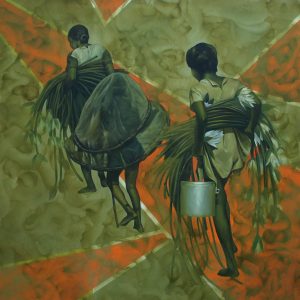Filters
Available Artwork
Price
Showing 1–9 of 121 results
-

TIEMPO 2/MIXTA SOBRE METAL
Oil on Hardboard
32 W x 32 H Inch
$2,870

TABLERO CON DIAGRAMA AUSENTE
Oil on Hardboard
24 W x 32 H Inch
$8,460

S.O.S.
Oil on Hardboard
36 W x 36 H Inch
$2,770

Return to home
Oil on Canvas
60 W x 55 H Inch
$3,740

The Goal
Oil on Canvas
40 W x 40 H Inch
$1,930
Other styles of paintings you may like
Origins of Oil Painting:
Embark on a journey through the captivating history of oil painting, a medium that has captivated artists and art lovers for centuries. While the use of oil as a binding medium in art can be traced back to ancient civilizations, it was during the Renaissance that oil painting truly flourished, becoming the quintessential medium for artistic expression in Western art. As Giorgio Vasari, the renowned Renaissance biographer and artist, wrote in his influential book "Lives of the Most Excellent Painters, Sculptors, and Architects," "Oil painting is the most beautiful of all techniques, because it permits the artist to rework and refine his forms at leisure."
Oil paints offer a unique combination of luminosity, depth, and versatility that has captivated artists for generations. The slow drying time allows for seamless blending of colors, creating subtle gradations and a luminous quality that seems to emanate from within the painting. This characteristic is beautifully exemplified in Leonardo da Vinci's iconic "Mona Lisa," where the sfumato technique, achieved through delicate layering of oil paints, creates a soft, almost ethereal effect. The Flemish masters, such as Jan van Eyck, further refined oil painting techniques, achieving astonishing detail and realism in their works.
The versatility of oil paints allows for a wide range of expressive possibilities.
Artists can apply thin glazes to build up luminous layers, or use thick impasto techniques to create texture and dimension. The Impressionists, with their focus on capturing the fleeting effects of light and atmosphere, further explored the potential of oil paints, creating masterpieces that shimmer with vibrant hues and atmospheric effects. As Claude Monet, a pioneer of Impressionism, eloquently stated, "When you go out to paint, try to forget what objects you have before you—a tree, a house, a field, or whatever. Merely think, here is a little square of blue, here an oblong of pink, here a streak of yellow, and paint it just as it looks to you."FAQs
What are the advantages of collecting oil paintings?Oil paintings offer several advantages for collectors, including:
-
Longevity: Oil paints are known for their durability and longevity, making them a lasting investment.
-
Richness and Depth: Oil paints create a unique depth and luminosity that other mediums often cannot replicate.
-
Versatility: Oil paints can be used to create a wide range of effects, from thin glazes to thick impasto textures.
-
Timeless Appeal: Oil paintings have a classic and timeless quality that complements various interior design styles.
How do I care for and preserve my oil paintings?Proper care is essential to preserve the beauty and value of your oil paintings. Avoid exposing them to direct sunlight, extreme temperature fluctuations, and excessive humidity. Dust them gently with a soft cloth or brush. If necessary, consult a professional art conservator for cleaning or restoration.
What are some of the different techniques used in oil painting?Oil painting techniques vary widely, allowing artists to achieve diverse effects. Some common techniques include:
-
Glazing: Applying thin, transparent layers of paint to build up depth and luminosity.
-
Impasto: Applying thick layers of paint to create texture and dimension.
-
Scumbling: Applying a thin layer of opaque paint over a dry layer to create a textured effect.
-
Blending: Seamlessly blending colors to create smooth transitions and gradations.
What should I consider when buying an oil painting?Consider the artist’s skill, the subject matter, the composition, the quality of the paint application, and the overall condition of the artwork. Think about how the painting will complement your existing collection or interior design. Elisium Art’s art advisors can provide expert guidance to help you select an oil painting that meets your preferences and investment goals.
Who are some of the most famous oil painters in history?Oil painting boasts a rich lineage of masters, including:
-
Leonardo da Vinci: A Renaissance master known for his iconic works like the “Mona Lisa” and “The Last Supper.”
-
Michelangelo: A Renaissance artist renowned for his frescoes in the Sistine Chapel and his sculptures like “David.”
-
Rembrandt van Rijn: A Dutch Golden Age painter known for his dramatic use of light and shadow and his insightful portraits.
-
Johannes Vermeer: A Dutch Golden Age painter known for his luminous interiors and depictions of everyday life.
-
Vincent van Gogh: A Post-Impressionist painter known for his expressive brushwork and vibrant colors.
Let us inspire you

 Want to receive exciting art and lifestyle content, directly to your box?
Want to receive exciting art and lifestyle content, directly to your box?
Thank you for Signing Up 
 error: Content is protected !!
error: Content is protected !!












